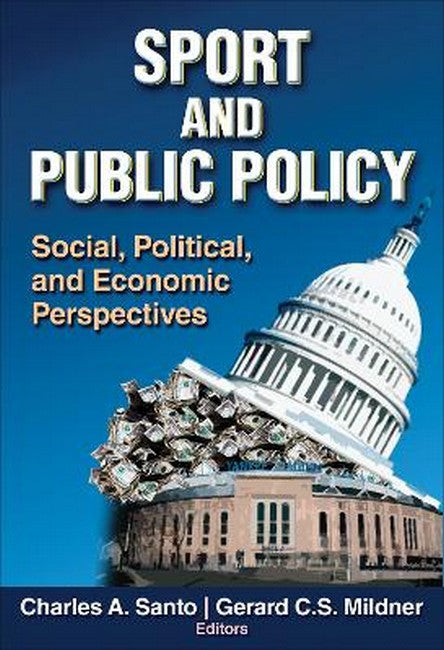Charles A. Santo, PhD, is assistant professor of city and regional planning at the University of Memphis in Tennessee. He also serves as coordinator of the Planning Innovations Technology Lab. In addition to having taught courses on sport and public policy, he has published many peer-reviewed articles on the relationship between sport, economic development, and urban public policy. He has been invited to share his research at regional, national, and international conferences. Dr. Santo is a member of the Urban Affairs Association. He earned a PhD in urban studies from PortlandStateUniversity. Gerard C. S. Mildner, PhD, has been at PortlandStateUniversity since 1991. Currently he is associate professor of urban studies and planning and director of the Center for Real Estate. Dr. Mildner has written extensively about real estate and location within cities. He is the author of several book chapters, including one on baseball and basketball stadium ownership and franchise incentives to relocate. He is a member of the Urban Affairs Association. He earned his PhD in economics from New YorkUniversity.
Request Academic Copy
Please copy the ISBN for submitting review copy form
Description
Part I. The Structure of Professional Sports Chapter 1.Cooperation Amidst Competition: The Nature of Sport Leagues Nathaniel Sampson and Gerard C.S. Mildner Why League Cooperation Is Necessary Downside of Cooperation Organized Baseball: Evolution of a Cartel Antitrust Law Interpretations and Baseball Antitrust and Other Leagues: Are All Sports Equal? Effect of Public Policy on the Balance of Power Future Trends Conclusion Chapter 2. Beyond the Major Leagues: Lessons from the Organization of International Sports Gerard C.S. Mildner Organization of Soccer, the World Sport Women's Soccer: The Trial of a Single-Entity League Rugby: The Contest over Professionalism, Nations, and Clubs Cricket: The Broadcaster's Leagues Lessons for American Sports Future Trends Conclusion Chapter 3. Why Professional Athletes Make So Much Money Zenon X. Zygmont The NHL's Missing Season Wage Determination in Professional Sports Free Agency Evaluating Player Productivity Is it Possible to Pay too Much? Future TrendsConclusion Part II. Professional Sports, Cities, and Public Finance Chapter 4. Economic Impact of Sport Stadiums, Teams and Events Charles A. Santo Public Cost of Big-Time Sports Economic Magnitude of Sports in Perspective Promoting Sport Investment Through Economic Impact Analysis Sources of Exaggeration in Economic Impact Analysis Ex Post Facto Empirical Evaluations Policy Implications on Predicted Economic Impacts Conclusion Chapter 5. Cities, Stadiums, and Subsidies: Why Cities Spend So Much on Sports Charles A. Santo Evolution of Major League Sport Facility Development Political Economy of Sport Facility Development Importance of Consumption Benefits Future Trends Conclusion Chapter 6. Community Ownership of Professional Sport Teams and the Role of Social Entrepreneurship Dorothy Norris-Tirrell and Susan Tomlinson Schmidt Identifying Community Ownership Alternatives Using the Nonprofit-Charitable Purpose Structure: The Memphis Redbirds Baseball Foundation Future Trends Conclusion Part III. Amateur Athletics, Participation, and Public Health Chapter 7.Influences of Urban Form on Physical Activity Jennifer Dill and Lynn Weigand Importance and Decline of Physical Activity in the United States How Urban Growth Has Made Us Less Active Public Policies to Increase Physical Activity Do These Strategies Work? Future Trends Conclusion Chapter 8. MLB's Mixed Messages: African American Participation in Baseball David C. Ogden Myth and Semiotics Analyzing MLB's Messages Moving from Political Speech to Myth Challenging Myth Policy Implications for Myth Making Future Trends Conclusion Chapter 9.Contradictions and Conflicts: Ethical Dilemmas Inherent in Big-Time College Sports Richard Southall, Mark S. Nagel, John Amis,and Crystal Southall College Sports Today National Collegiate Athletic Association (NCAA) Corporatization in College Sports Institutional Logics Case Study: 2006 NCAA Men's Basketball Tournament Broadcasts Future Trends Conclusion Chapter 10. Sport, Doping, and Public Policy Bryan E. Denham Mediated Doping Representations and the Formation of Public Policy Sporting Competition and the Formation of Regulatory Bodies Media Representations, Government Hearings, and Public Policy in the 21st Century Future Trends Conclusion Part IV. Sports and Globalization Chapter 11. Political Economy of the Olympic Games Gregory Andranovich, Matthew J. Burbank, and Charles H. Heying Globalization, the New Economy, and Political Economy Political Economy and the Olympic Games Los Angeles: The Market Matters Most Atlanta: The State Matters Most Mexico City: Civil Society Matters Most Future Trends Conclusion Chapter 12. American Baseball and the Global Labor Market: Resistance and Hegemony in the Caribbean Charles A. Santo Globalization of American Professional Baseball Shared History and Parallel Development of Caribbean Baseball Dominican Dependency, Underdevelopment, and Exploitation Cuban Nationalism and Resistance Movement Along the Spectrum Future Trends Conclusion Chapter 13. Expanding Global Consumer Market for American Sports: The World Baseball Classic Mark S. Nagel, Matt T. Brown, Dan A. Rascher, and Chad D. McEvoy Baseball's Worldwide Development The Consumption of MLB in the United States The Creation of the World Baseball Classic World Baseball Classic Revenue Sources Future TrendsConclusion

